A Laser-Based Multipass Absorption Sensor for Sub-ppm Detection of Methane, Acetylene and Ammonia
Abstract
:1. Introduction
2. Spectroscopic Fundamentals
3. Sensor Configurations
4. Results and Discussion
5. Conclusions
Author Contributions
Funding
Institutional Review Board Statement
Informed Consent Statement
Data Availability Statement
Acknowledgments
Conflicts of Interest
References
- Hodgkinson, J.; Tatam, R.P. Optical gas sensing: A review. Meas. Sci. Technol. 2013, 24, 59. [Google Scholar] [CrossRef] [Green Version]
- Wang, C.J.; Sahay, P. Breath Analysis Using Laser Spectroscopic Techniques: Breath Biomarkers, Spectral Fingerprints, and Detection Limits. Sensors 2009, 9, 8230–8262. [Google Scholar] [CrossRef]
- Ma, Y.F. Recent Advances in QEPAS and QEPTS Based Trace Gas Sensing: A Review. Front. Phys. 2020, 8, 12. [Google Scholar] [CrossRef]
- Elia, A.; Lugara, P.M.; di Franco, C.; Spagnolo, V. Photoacoustic Techniques for Trace Gas Sensing Based on Semiconductor Laser Sources. Sensors 2009, 9, 9616–9628. [Google Scholar] [CrossRef] [Green Version]
- Du, Z.H.; Zhang, S.; Li, J.Y.; Gao, N.; Tong, K.B. Mid-Infrared Tunable Laser-Based Broadband Fingerprint Absorption Spectroscopy for Trace Gas Sensing: A Review. Appl. Sci. 2019, 9, 338. [Google Scholar] [CrossRef] [Green Version]
- Goldenstein, C.S.; Spearrin, R.M.; Jeffries, J.B.; Hanson, R.K. Infrared laser-absorption sensing for combustion gases. Prog. Energy Combust. Sci. 2017, 60, 132–176. [Google Scholar] [CrossRef] [Green Version]
- Hanson, R.K. Applications of quantitative laser sensors to kinetics, propulsion and practical energy systems. Proc. Combust. Inst. 2011, 33, 1–40. [Google Scholar] [CrossRef]
- Xie, Y.C.; Hou, Z.M.; Liu, H.J.; Cao, C.; Qi, J.G. The sustainability assessment of CO2 capture, utilization and storage (CCUS) and the conversion of cropland to forestland program (CCFP) in the Water-Energy-Food (WEF) framework towards China’s carbon neutrality by 2060. Environ. Earth Sci. 2021, 80, 17. [Google Scholar] [CrossRef]
- Jia, K. Goals on the road: Instituional innovations in carbon peak and carbon neutrality. J. Chin. Econ. Bus. Stud. 2021, 13, 1–3. [Google Scholar] [CrossRef]
- Available online: https://www.epa.gov/ghgemissions/overview-greenhouse-gases (accessed on 1 December 2021).
- Wang, Y.; Chung, S.H. Soot formation in laminar counterflow flames. Prog. Energy Combust. Sci. 2019, 74, 152–238. [Google Scholar] [CrossRef]
- Bento, D.S.; Thomson, K.A.; Gulder, O.L. Soot formation and temperature field structure in laminar propane-air diffusion flames at elevated pressures. Combust. Flame 2006, 145, 765–778. [Google Scholar] [CrossRef] [Green Version]
- Valera-Medina, A.; Xiao, H.; Owen-Jones, M.; David, W.I.F.; Bowen, P.J. Ammonia for power. Prog. Energy Combust. Sci. 2018, 69, 63–102. [Google Scholar] [CrossRef]
- Khan, M.A.H.; Rao, M.V.; Li, Q.L. Recent Advances in Electrochemical Sensors for Detecting Toxic Gases: NO2, SO2 and H2S. Sensors 2019, 19, 905. [Google Scholar] [CrossRef] [Green Version]
- Erfan, M.; Sabry, Y.M.; Sakr, M.; Mortada, B.; Medhat, M.; Khalil, D. On-Chip Micro-Electro-Mechanical System Fourier Transform Infrared (MEMS FT-IR) Spectrometer-Based Gas Sensing. Appl. Spectmsc. 2016, 70, 897–904. [Google Scholar] [CrossRef]
- De Biasio, M.; Leitner, R.; Krall, C.; Krivec, M.; Wilk, A.; Mizaikoff, B.; Waldner, R.; Starmans, F.; Maier, D. Ethylene Gas Sensing Using Non-Dispersive Infrared Spectroscopy. In Proceedings of the 15th IEEE Sensors Conference, Orlando, FL, USA, 30 October–3 November 2016; IEEE: Orlando, FL, USA, 2016. [Google Scholar]
- Yao, C.; Wang, Z.; Wang, Q.; Bian, Y.; Chen, C.; Zhang, L.; Ren, W. Interband cascade laser absorption sensor for real-time monitoring of formaldehyde filtration by a nanofiber membrane. Appl. Opt. 2018, 57, 8005–8010. [Google Scholar] [CrossRef] [PubMed]
- Wang, Z.; Cheong, K.P.; Li, M.; Wang, Q.; Ren, W. Theoretical and Experimental Study of Heterodyne Phase-Sensitive Dispersion Spectroscopy with an Injection-Current-Modulated Quantum Cascade Laser. Sensors 2020, 20, 6176. [Google Scholar] [CrossRef]
- Martin-Mateos, P.; Acedo, P. Heterodyne phase-sensitive detection for calibration-free molecular dispersion spectroscopy. Opt. Express 2014, 22, 15143–15153. [Google Scholar] [CrossRef]
- Hangauer, A.; Spinner, G.; Nikodem, M.; Wysocki, G. High frequency modulation capabilities and quasi single-sideband emission from a quantum cascade laser. Opt. Express 2014, 22, 23439–23455. [Google Scholar] [CrossRef]
- Wang, Z.; Li, Z.; Ren, W. Quartz-enhanced photoacoustic detection of ethylene using a 10.5 μm quantum cascade laser. Opt. Express 2016, 24, 4143–4154. [Google Scholar] [CrossRef]
- Yao, C.; Wang, Q.; Lin, Y.; Jin, W.; Xiao, L.; Gao, S.; Wang, Y.; Wang, P.; Ren, W. Photothermal CO detection in a hollow-core negative curvature fiber. Opt. Lett. 2019, 44, 4048–4051. [Google Scholar] [CrossRef] [PubMed]
- Hanson, R.K.; Davidson, D.F. Recent advances in laser absorption and shock tube methods for studies of combustion chemistry. Prog. Energy Combust. Sci. 2014, 44, 103–114. [Google Scholar] [CrossRef]
- Philippe, L.C.; Hanson, R.K. Laser diode wavelength-modulation spectroscopy for simultaneous measurement of temperature, pressure, and velocity in shock-heated oxygen flows. Appl. Opt. 1993, 32, 6090–6103. [Google Scholar] [CrossRef] [PubMed]
- Rieker, G.B.; Jeffries, J.B.; Hanson, R.K. Calibration-free wavelength-modulation spectroscopy for measurements of gas temperature and concentration in harsh environments. Appl. Opt. 2009, 48, 5546–5560. [Google Scholar] [CrossRef]
- Ren, W.; Jeffries, J.B.; Hanson, R.K. Temperature sensing in shock-heated evaporating aerosol using wavelength-modulation absorption spectroscopy of CO2near 2.7 µm. Meas. Sci. Technol. 2010, 21, 105603. [Google Scholar] [CrossRef]
- Vanderover, J.; Wang, W.; Oehlschlaeger, M.A. A carbon monoxide and thermometry sensor based on mid-IR quantum-cascade laser wavelength-modulation absorption spectroscopy. Appl. Phys. B 2011, 103, 959–966. [Google Scholar] [CrossRef]
- Liu, C.; Xu, L.; Li, F.; Cao, Z.; Tsekenis, S.A.; McCann, H. Resolution-doubled one-dimensional wavelength modulation spectroscopy tomography for flame flatness validation of a flat-flame burner. Appl. Phys. B 2015, 120, 407–416. [Google Scholar] [CrossRef]
- Xu, K.; Zhao, X.; Wang, Z.; Chen, J.; Li, T.; Zheng, Z.; Ren, W. Multipass-assisted dual-comb gas sensor for multi-species detection using a free-running fiber laser. Appl. Phys. B 2020, 126, 39. [Google Scholar] [CrossRef]
- Cui, R.Y.; Dong, L.; Wu, H.P.; Ma, W.G.; Xiao, L.T.; Jia, S.T.; Chen, W.D.; Tittel, F.K. Three-Dimensional Printed Miniature Fiber-Coupled Multipass Cells with Dense Spot Patterns for ppb-Level Methane Detection Using a Near-IR Diode Laser. Anal. Chem. 2020, 92, 13034–13041. [Google Scholar] [CrossRef]
- Ren, W.; Jiang, W.Z.; Tittel, F.K. Single-QCL-based absorption sensor for simultaneous trace-gas detection of CH4 and N2O. Appl. Phys. B-Lasers Opt. 2014, 117, 245–251. [Google Scholar] [CrossRef]
- Liu, K.; Wang, L.; Tan, T.; Wang, G.S.; Zhang, W.J.; Chen, W.D.; Gao, X.M. Highly sensitive detection of methane by near-infrared laser absorption spectroscopy using a compact dense-pattern multipass cell. Sens. Actuator B-Chem. 2015, 220, 1000–1005. [Google Scholar] [CrossRef] [Green Version]
- Shao, L.G.; Fang, B.; Zheng, F.; Qiu, X.B.; He, Q.S.; Wei, J.L.; Li, C.L.; Zhao, W.X. Simultaneous detection of atmospheric CO and CH4 based on TDLAS using a single 2.3 mu m DFB laser. Spectroc. Acta Part A-Mol. Biomol. Spectr. 2019, 222, 6. [Google Scholar] [CrossRef] [PubMed]
- Sun, H.Y.; Ma, Y.F.; He, Y.; Qiao, S.D.; Yang, X.T.; Tittel, F.K. Highly sensitive acetylene detection based on a compact multi-pass gas cell and optimized wavelength modulation technique. Infrared Phys. Technol. 2019, 102, 5. [Google Scholar] [CrossRef]
- Jin, W.L.; Zhang, H.; Hu, M.; Hu, M.P.; Wei, Y.B.; Liang, J.Q.; Kan, R.F.; Wang, Q. A Robust Optical Sensor for Remote Multi-Species Detection Combining Frequency-Division Multiplexing and Normalized Wavelength Modulation Spectroscopy. Sensors 2021, 21, 1073. [Google Scholar] [CrossRef]
- Guo, X.Q.; Zheng, F.; Li, C.L.; Yang, X.F.; Li, N.; Liu, S.P.; Wei, J.L.; Qiu, X.B.; He, Q.S. A portable sensor for in-situ measurement of ammonia based on near-infrared laser absorption spectroscopy. Opt. Lasers Eng 2019, 115, 243–248. [Google Scholar] [CrossRef]
- Li, J.Y.; Zhang, C.; Wei, Y.Y.; Du, Z.H.; Sun, F.H.; Ji, Y.; Yang, X.T.; Liu, C. In situ, portable and robust laser sensor for simultaneous measurement of ammonia, water vapor and temperature in denitrification processes of coal fired power plants. Sens. Actuator B-Chem. 2019, 305, 127533. [Google Scholar] [CrossRef]
- Bai, Y.R.; Yu, H.J.; He, C.J.; Miao, Z.; Dou, R.; Zhang, Y.; Lin, X.C. A numerical simulation of a near-infrared three-channel trace ammonia detection system using hollow core photonic crystal fiber. Optik 2021, 227, 166006. [Google Scholar] [CrossRef]
- Raza, M.; Ma, L.H.; Yao, S.C.; Chen, L.F.; Ren, W. High-temperature dual-species (CO/NH3) detection using calibration-free scanned-wavelength-modulation spectroscopy at 2.3 μm. Fuel 2021, 305, 121591. [Google Scholar] [CrossRef]
- Hanson, R.K.; Spearrin, R.M.; Goldenstein, C.S. Spectroscopy and Optical Diagnostics for Gases; Springer International Publishing: Cham, Switzerland, 2016. [Google Scholar]
- Reid, J.; Labrie, D. Second-harmonic detection with tunable diode lasers—Comparison of experiment and theory. Appl. Phys. B 1981, 26, 203–210. [Google Scholar] [CrossRef]
- Gordon, I.E.; Rothman, L.S.; Hargreaves, R.J.; Hashemi, R.; Karlovets, E.V.; Skinner, F.M.; Conway, E.K.; Hill, C.; Kochanov, R.V.; Tan, Y.; et al. The HITRAN2020 molecular spectroscopic database. J. Quant. Spectrosc. Radiat. Transfer. 2021, 277, 107949. [Google Scholar] [CrossRef]
- Wang, Q.; Wang, Z.; Ren, W. Wavelength-stabilization-based photoacoustic spectroscopy for methane detection. Meas. Sci. Technol. 2017, 28, 065102. [Google Scholar] [CrossRef]
- Li, J.S.; Yu, B.L.; Zhao, W.X.; Chen, W.D. A Review of Signal Enhancement and Noise Reduction Techniques for Tunable Diode Laser Absorption Spectroscopy. Appl. Spectrosc. Rev. 2014, 49, 666–691. [Google Scholar] [CrossRef]
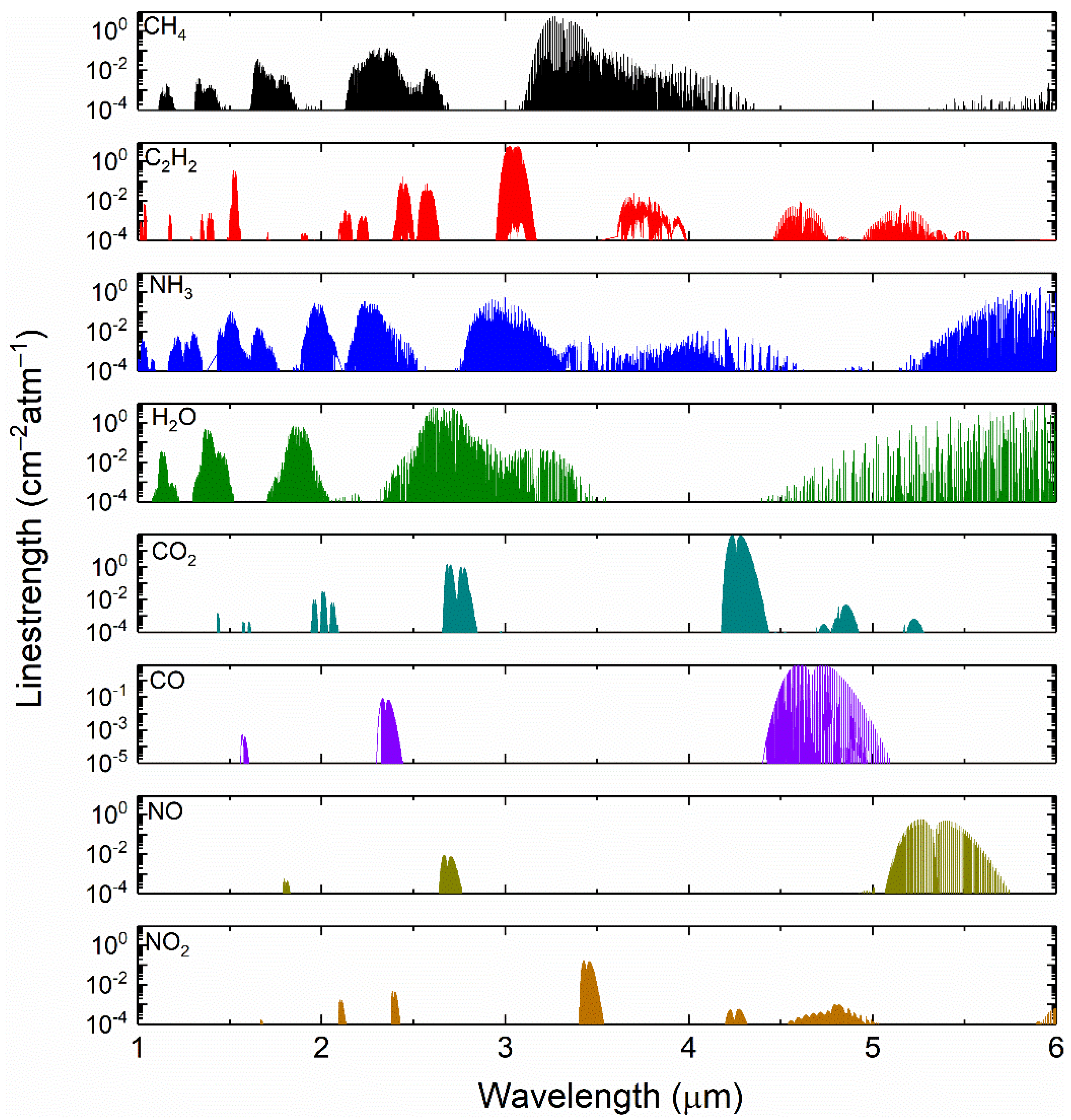

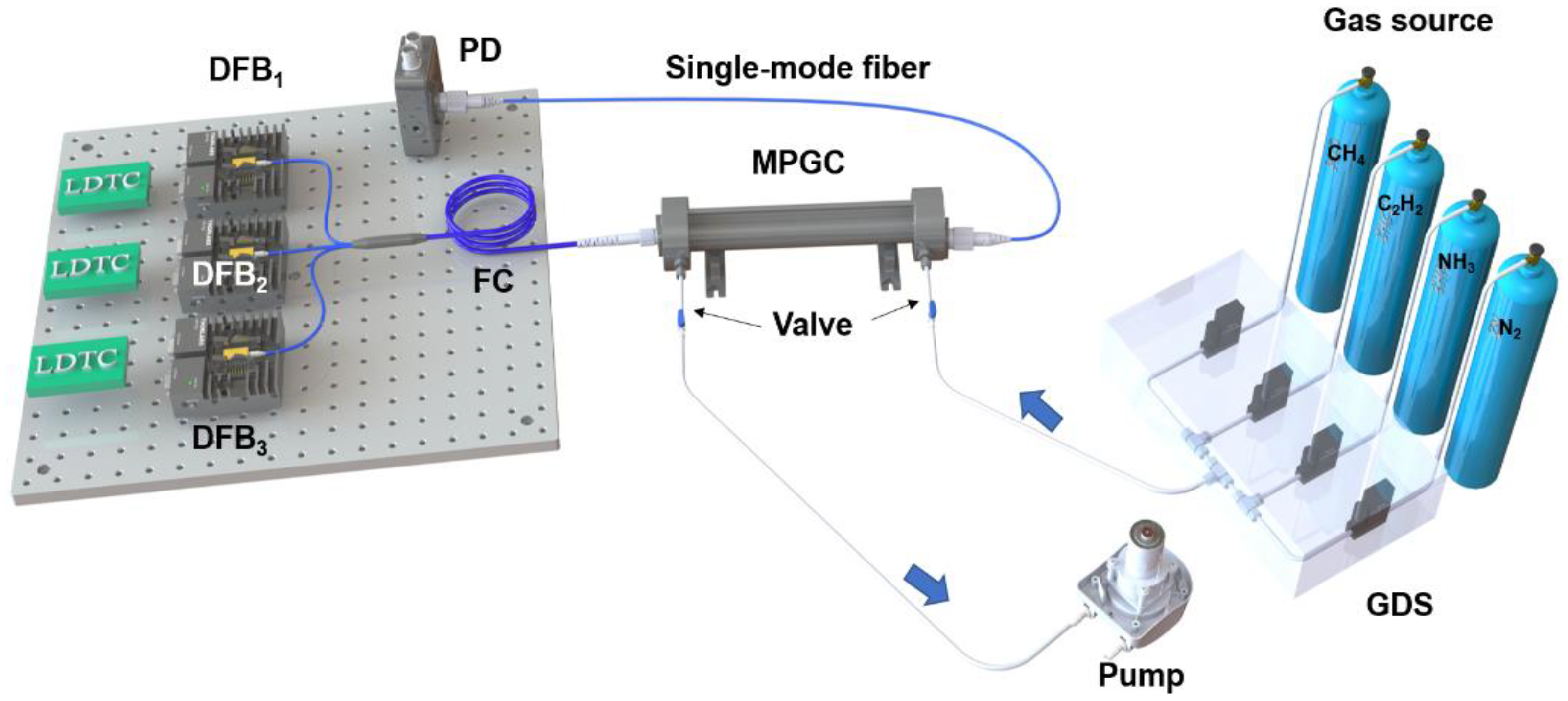
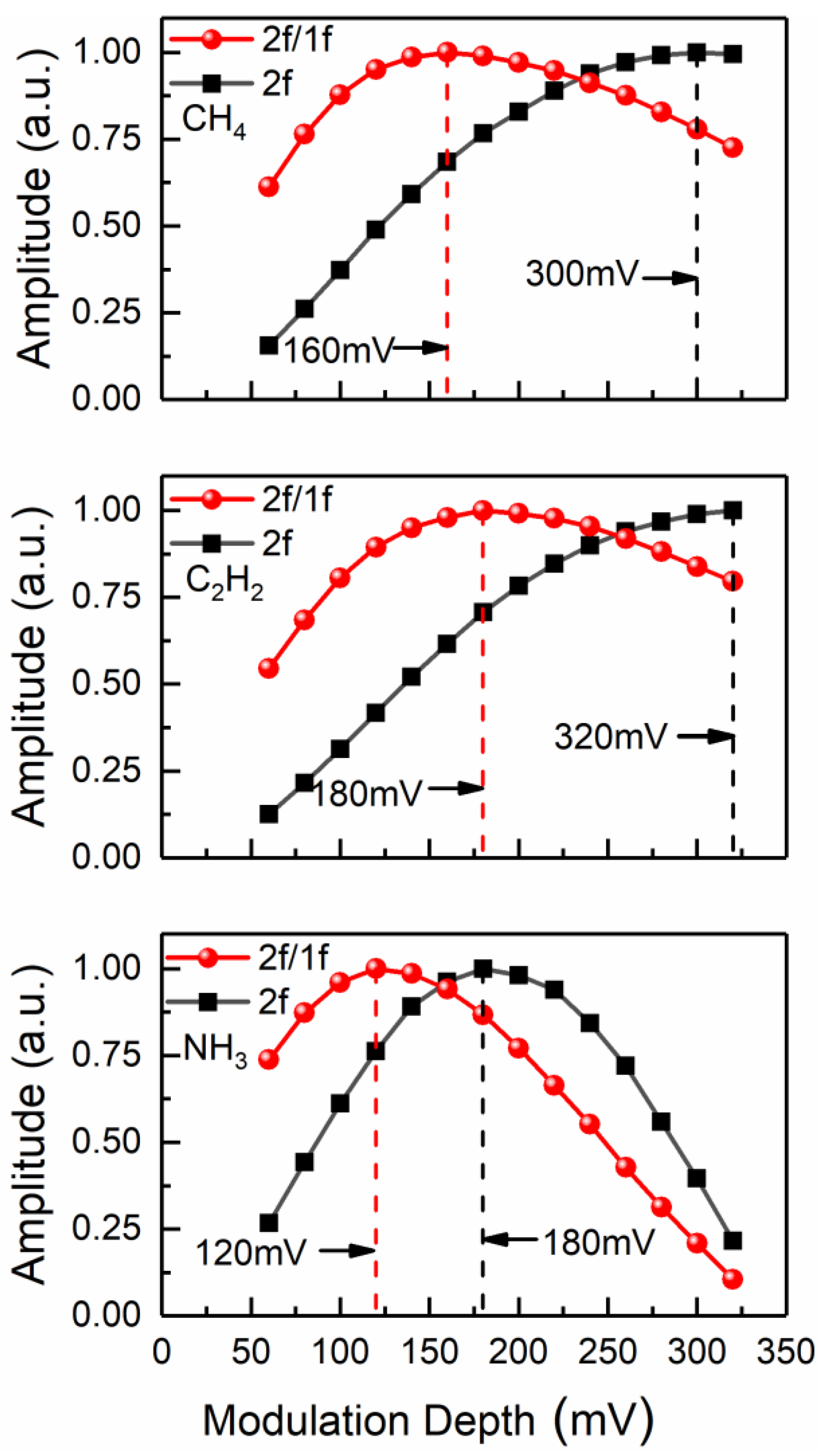

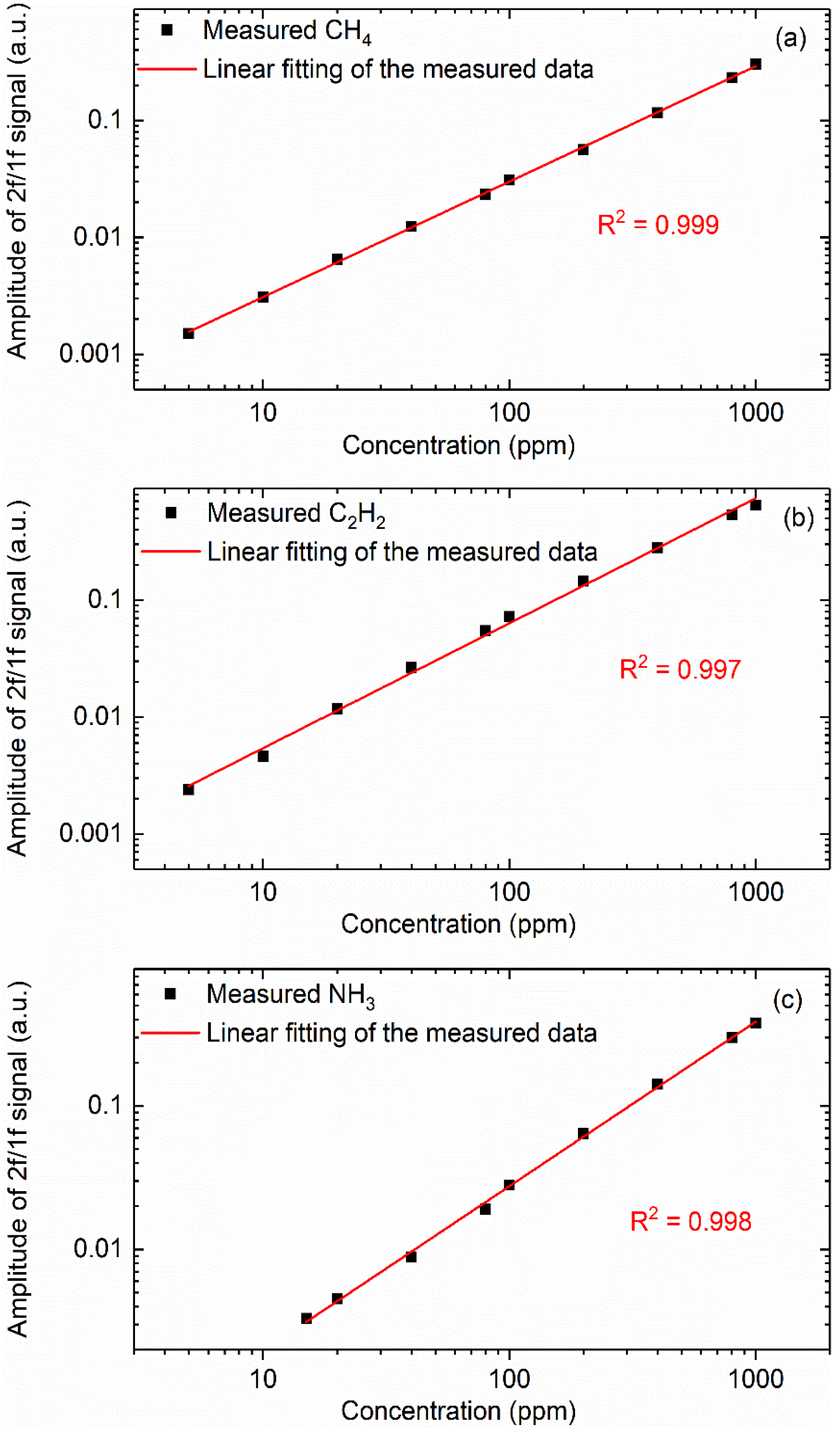
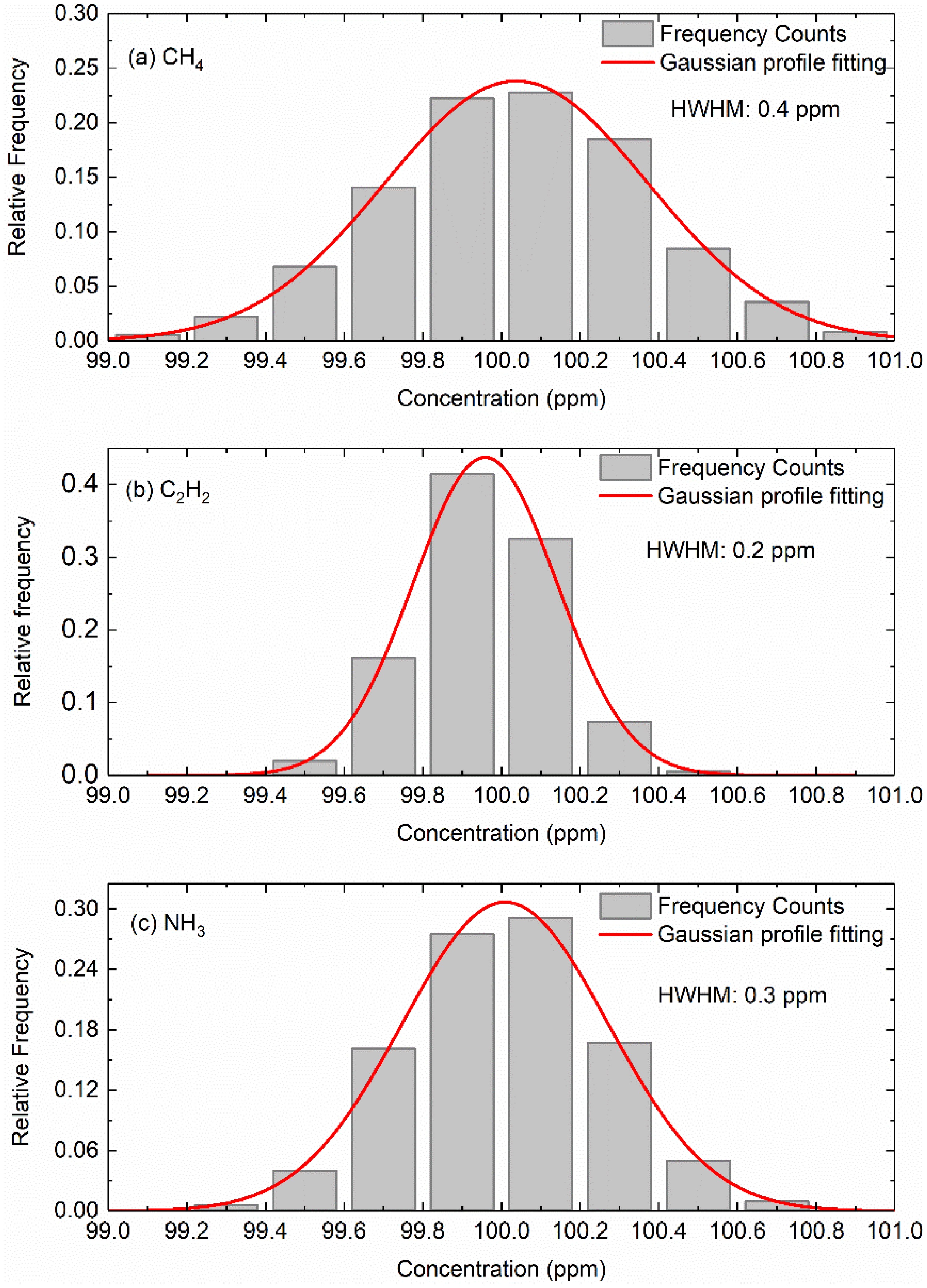
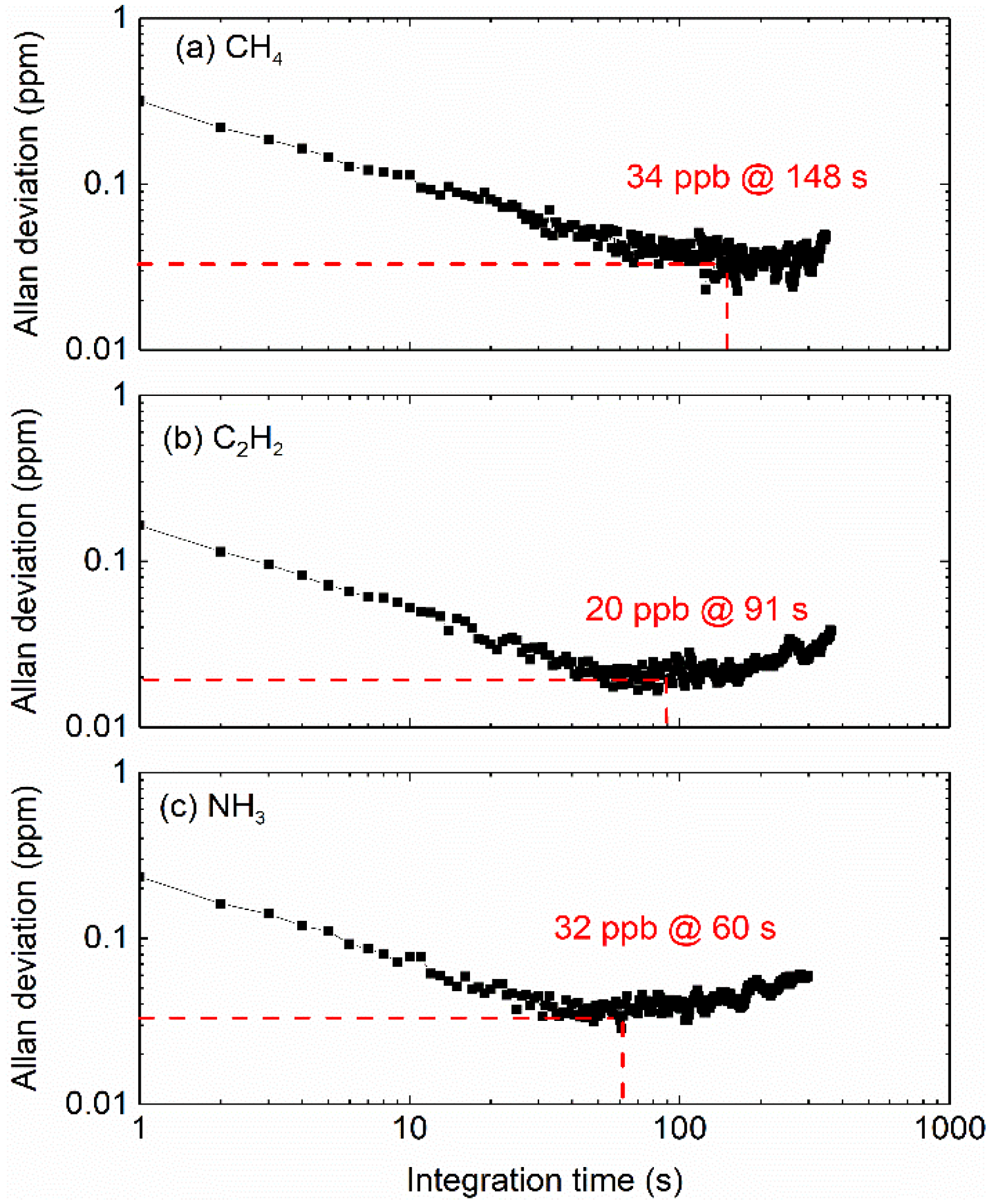
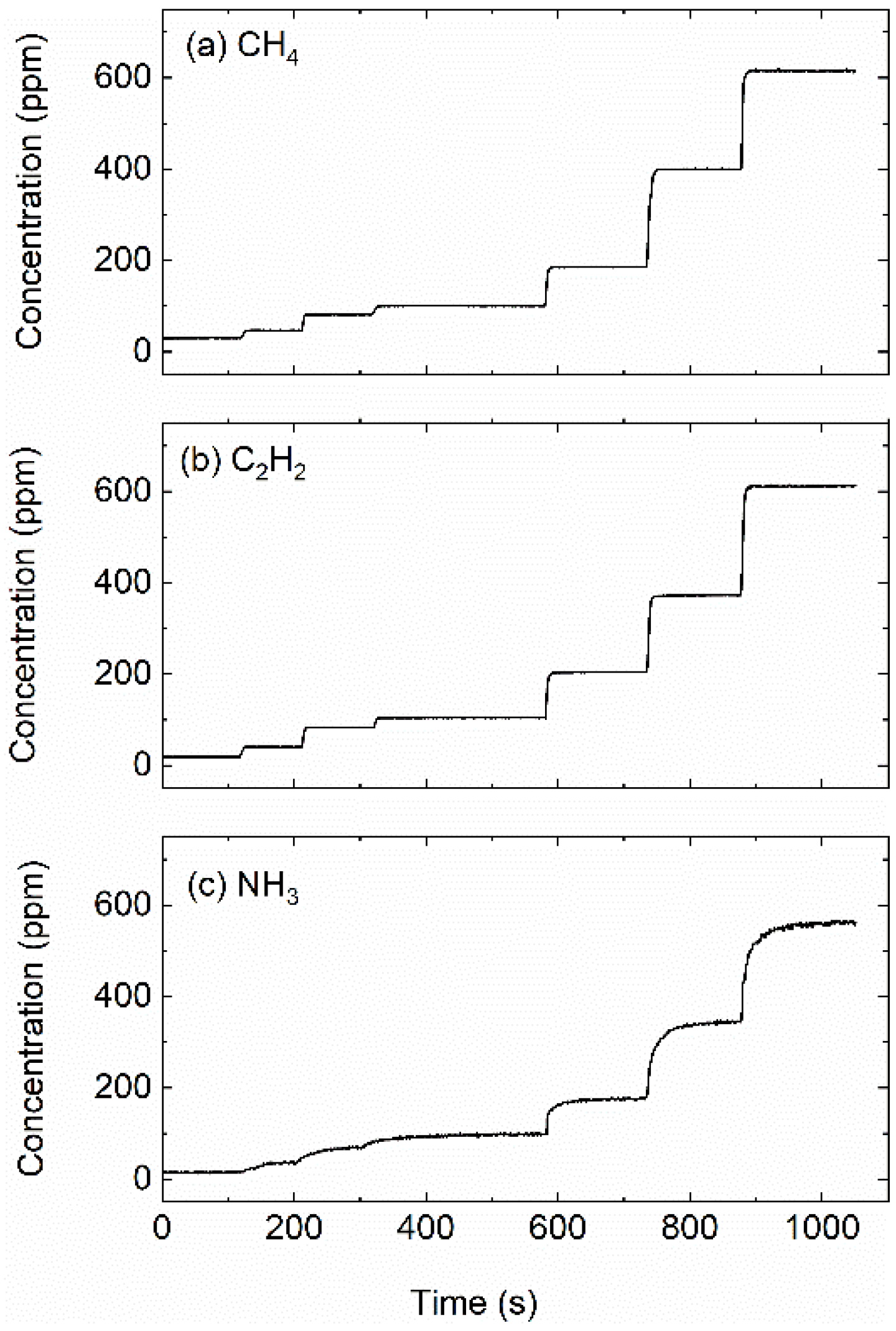
Publisher’s Note: MDPI stays neutral with regard to jurisdictional claims in published maps and institutional affiliations. |
© 2022 by the authors. Licensee MDPI, Basel, Switzerland. This article is an open access article distributed under the terms and conditions of the Creative Commons Attribution (CC BY) license (https://creativecommons.org/licenses/by/4.0/).
Share and Cite
Duan, W.; Yan, F.; Wang, Y.; Zhang, H.; Ma, L.; Wen, D.; Wang, W.; Sheng, G.; Wang, Q. A Laser-Based Multipass Absorption Sensor for Sub-ppm Detection of Methane, Acetylene and Ammonia. Sensors 2022, 22, 556. https://doi.org/10.3390/s22020556
Duan W, Yan F, Wang Y, Zhang H, Ma L, Wen D, Wang W, Sheng G, Wang Q. A Laser-Based Multipass Absorption Sensor for Sub-ppm Detection of Methane, Acetylene and Ammonia. Sensors. 2022; 22(2):556. https://doi.org/10.3390/s22020556
Chicago/Turabian StyleDuan, Wei, Fuwu Yan, Yu Wang, Hui Zhang, Liuhao Ma, Daxin Wen, Wei Wang, Gang Sheng, and Qiang Wang. 2022. "A Laser-Based Multipass Absorption Sensor for Sub-ppm Detection of Methane, Acetylene and Ammonia" Sensors 22, no. 2: 556. https://doi.org/10.3390/s22020556
APA StyleDuan, W., Yan, F., Wang, Y., Zhang, H., Ma, L., Wen, D., Wang, W., Sheng, G., & Wang, Q. (2022). A Laser-Based Multipass Absorption Sensor for Sub-ppm Detection of Methane, Acetylene and Ammonia. Sensors, 22(2), 556. https://doi.org/10.3390/s22020556








